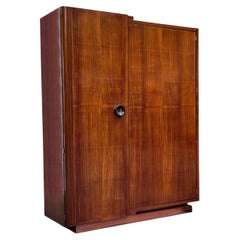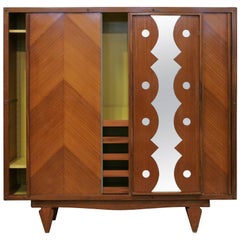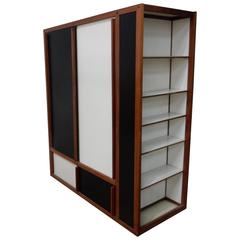Wardrobe By Andre Sornay
Vintage 1940s French Art Deco Wardrobes and Armoires
Wood
Recent Sales
Vintage 1960s French Mid-Century Modern Wardrobes and Armoires
Mahogany
Vintage 1960s French Mid-Century Modern Wardrobes and Armoires
Mahogany, Wood
Vintage 1930s French Art Deco Wardrobes and Armoires
Brass
20th Century French Mid-Century Modern Wardrobes and Armoires
Metal
Vintage 1950s French Dressers
Wood, Lacquer
Vintage 1950s French Mid-Century Modern Wardrobes and Armoires
Metal
Vintage 1950s French Mid-Century Modern Wardrobes and Armoires
Metal
Vintage 1950s French Mid-Century Modern Wardrobes and Armoires
Vintage 1950s French Mid-Century Modern Cabinets
Wood, Teak
Mid-20th Century French Wardrobes and Armoires
Metal
Mid-20th Century French Mid-Century Modern Wardrobes and Armoires
Metal
Vintage 1950s French Wardrobes and Armoires
height adjustable oak veneer shelving.
Vintage 1950s French Wardrobes and Armoires
Vintage 1950s French Mid-Century Modern Cabinets
Metal
People Also Browsed
20th Century Swedish Scandinavian Modern Gueridon
Birch
Mid-20th Century French French Provincial Beds and Bed Frames
Wicker
Vintage 1950s Dutch Mid-Century Modern Daybeds
Steel
Antique Late 19th Century Portuguese Baroque Beds and Bed Frames
Walnut
Antique Early 19th Century English Chinoiserie Commodes and Chests of Dr...
Wood
Vintage 1960s French Chandeliers and Pendants
Alabaster
Vintage 1920s German Art Deco Armchairs
Fabric, Upholstery, Wood, Birch
21st Century and Contemporary Italian Modern Screens and Room Dividers
Aluminum
Vintage 1950s French Mid-Century Modern Cabinets
Wood, Oak
Vintage 1930s French Art Deco Coffee and Cocktail Tables
Wood
20th Century French Art Deco Cabinets
Brass, Bronze
Vintage 1950s American Mid-Century Modern Desks and Writing Tables
Brass
20th Century French Mid-Century Modern Cabinets
Brass
Mid-20th Century French Mid-Century Modern Daybeds
Elm
Vintage 1950s Swedish Scandinavian Modern Commodes and Chests of Drawers
Pine
Vintage 1960s Danish Scandinavian Modern Beds and Bed Frames
Teak
Andre Sornay for sale on 1stDibs
Although he is among the least known of the like-minded French Art Deco furniture designers of his era, André Sornay introduced innovative fabrication techniques and a unique decorative style to his modernist seating, case pieces and other creations.
Sornay was born in Lyon in 1902, and graduated from École Nationale Supérieure des Beaux-Arts de Lyon in 1918. His career as a furniture designer began in 1919 when he was appointed head of his family’s furniture company after his father’s death.
In the early 1920s — inspired by the Bauhaus and De Stijl as well as his friends and fellow French avant-garde designers Francis Jourdain and Pierre Chareau — Sornay shifted the company’s focus from manufacturing period reproductions to creating contemporary designs.
Sornay’s work fused tradition with modernism. He preferred to work with metals, exotic woods such as mahogany and rosewood, rubber and Duco lacquer for a range of cabinets, desks, chairs and mirrors. Sornay’s pieces featured sleek brass drawer pulls and sharply geometric lines, and the distinctive mode that he worked in was known throughout Lyon as “Le Style Sornay.”
Sornay was also recognized for his inventive design methods that were not only decorative but functional. In 1932, he patented the cloudage technique — studding the perimeter of veneered furniture panels with uniform brass nails. Sornay integrated this technique into his wardrobes, side tables and the armchairs he designed, which were frequently defined by clean lines and sharp angles. In the early 1950s, he also patented a technique called the “Tigette,” which allowed for quick and easy assembly or disassembly of modular furniture — a forerunner to IKEA’s flat-packed furniture.
While Sornay isn’t as well known as other European modernists like Le Corbusier and Charlotte Perriand, he attracted modest attention at exhibitions of the day, such as the 1923 Salon d’Automne and the 1925 Exposition Internationale des Arts Décoratifs et Industriels Modernes in Paris, the design fair that brought the Art Deco style to the world. He was awarded the bronze medal at Paris’s Exposition Internationale des Arts et Techniques dans la Vie Moderne in 1937.
In the late 1950s, Sornay ceded control of his furniture design company to his children, remaining as an advisor until production ceased in 1999. He died the following year.
On 1stDibs, discover a range of vintage André Sornay case pieces and storage cabinets, seating and tables.
Finding the Right Wardrobes-armoires for You
When shopping for antique and vintage wardrobes and armoires for your home, there are several things to keep in mind, not least of which is question number 1:
What is the difference between an armoire and a wardrobe?
The difference between an armoire and a wardrobe is actually simple: An armoire is merely an ornate wardrobe. A wardrobe is a tall, streamlined storage cabinet that usually has some combination of drawers, shelves and hanging rods.
Antique and vintage armoires, on the other hand, are freestanding, heavy wooden structures that typically feature decorative metal hinges and pictorial carvings. Armoires are large cabinets that aren’t outfitted with the varied storage features that wardrobes now commonly have. Armoires often have one or two doors and a hanging bar and allow for quick access. Whether a minimalist mid-century modern wardrobe or grandiose Victorian-era armoire is the right fit for you, both are highly functional furnishings and can be a smart storage solution.
Armoires have been around since medieval times, and initially they may have housed weapons and armor. In their early days, armoires were often adorned with elaborate carvings and lavish paintings, particularly in Renaissance-era France. During the 18th century and later, armoires were widely known as “presses” for hanging clothes, and they were so large that they swallowed up the room where they stood.
In today’s modern homes, an antique armoire can be a striking, architectural work of art amid comparably unadorned furnishings. Whether you’re using your piece in the kitchen for cookware or as a food pantry, in the bedroom for clothes or in the living room as a media console, it will likely become a lovable focal point.
The evolution of the armoire can be seen in today’s corner wardrobes, which may rest on an asymmetrical base to account for corner placement, and even mirrored wardrobes, which feature a mirror affixed to the inside panel of one of the doors for convenience. Contemporary wardrobes commonly feature additional sliding trays and drawers and hanging space for clothing or linens, and the cabinet doors make them ideal for concealing televisions and computer monitors when such devices aren’t in use.
When choosing the right wardrobe or vintage armoire for your home, it’s good to have the following in mind: What are you planning to store in it? How much of what you’re storing will need to be housed in it? It should be big enough to accommodate your needs. What is the size of the room where your wardrobe or armoire will live? A large new piece of furniture in a modest space can easily become a hindrance if you have to navigate your way around it during your daily routine, so be mindful of the area you'll need in order to move freely.
Whether you are looking for an antique walnut armoire or a simple contemporary wardrobe, find the right piece for your home today on 1stDibs.


